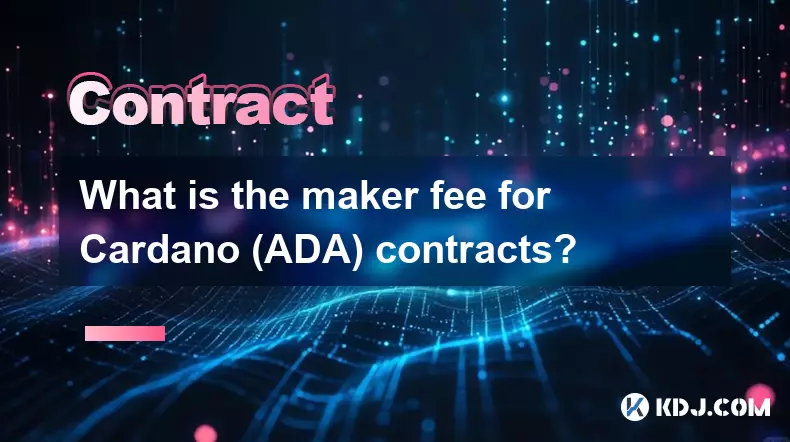-
 bitcoin
bitcoin $122288.232522 USD
0.16% -
 ethereum
ethereum $4480.662914 USD
-0.22% -
 xrp
xrp $2.962747 USD
-2.32% -
 tether
tether $1.000120 USD
-0.05% -
 bnb
bnb $1145.654223 USD
-2.07% -
 solana
solana $227.105217 USD
-1.67% -
 usd-coin
usd-coin $0.999548 USD
-0.02% -
 dogecoin
dogecoin $0.250875 USD
-2.04% -
 tron
tron $0.340654 USD
-0.49% -
 cardano
cardano $0.837968 USD
-2.52% -
 hyperliquid
hyperliquid $48.960449 USD
0.06% -
 chainlink
chainlink $22.049280 USD
-1.33% -
 ethena-usde
ethena-usde $1.000404 USD
0.02% -
 sui
sui $3.586212 USD
0.20% -
 avalanche
avalanche $29.894916 USD
-4.18%
What is the maker fee for Cardano (ADA) contracts?
On Cardano DEXs like SundaeSwap and Minswap, "maker" fees aren't standard—liquidity providers earn ~0.25% of each 0.3% swap fee, plus potential rewards, for enabling trades.
Sep 26, 2025 at 09:01 am

Understanding Maker Fees in Cardano (ADA) Contracts
1. The concept of maker fees applies broadly across decentralized exchanges and smart contract platforms, including those built on the Cardano blockchain. When a user places a limit order that adds liquidity to the order book rather than immediately matching with an existing order, they are considered a 'maker.' In return for providing liquidity, maker fees are typically lower than taker fees or sometimes even zero depending on the exchange's fee structure.
2. Cardano itself does not natively support traditional order books since it is primarily a proof-of-stake blockchain focused on secure and scalable smart contracts. Instead, decentralized exchanges (DEXs) operating on Cardano, such as SundaeSwap or Minswap, implement their own fee models. These DEXs use automated market maker (AMM) mechanisms rather than order books, which changes how maker and taker roles are defined compared to centralized exchanges.
3. In AMM-based systems on Cardano, every trade incurs a swap fee, usually a small percentage of the transaction value. This fee is distributed among liquidity providers who deposit assets into liquidity pools. While these platforms don’t label fees as “maker” or “taker” in the conventional sense, liquidity providers effectively act as makers by supplying assets to the pool and earning a share of trading fees.
4. Most Cardano DEXs charge a standard swap fee ranging from 0.3% to 0.5% per trade. A portion of this fee—typically around 0.25%—goes directly to liquidity providers as compensation for their role in enabling trades. The remaining fraction may be used to fund protocol development, governance, or token buybacks, depending on the specific platform’s economic model.
5. It's important to note that there is no universal maker fee for ADA contracts because fee structures are determined at the application level, not by the Cardano protocol itself. Users interacting with different DEXs will encounter varying fee schedules based on each platform’s design. Always review the fee disclosures provided by the specific decentralized application before engaging in any transaction involving ADA or other tokens.
Liquidity Provision and Incentive Mechanisms
1. On Cardano-based decentralized exchanges, users contribute pairs of tokens to liquidity pools, enabling others to trade between them seamlessly. By doing so, they assume the role traditionally associated with makers in order-book exchanges. Their contribution increases market depth and reduces slippage for traders.
2. In return for locking up their funds, liquidity providers earn passive income through a share of the transaction fees generated by swaps within the pool. For instance, if a pool charges a 0.3% fee on each trade, a significant portion—often 0.25%—is redistributed proportionally to all liquidity providers based on their stake in the pool.
3. Some platforms also offer additional incentives in the form of reward tokens distributed over time. These incentives aim to attract more participants to provide liquidity, especially during the early stages of a DEX launch or for less popular trading pairs.
4. Impermanent loss remains a risk for liquidity providers, particularly when the price ratio of the two assets in a pair shifts significantly after deposit. Despite being compensated via fees, providers may still experience net losses under volatile market conditions.
5. Transparent tracking tools and analytics dashboards are available on many Cardano DEX interfaces, allowing users to monitor their accumulated fees, current pool composition, and historical performance before deciding whether to add or withdraw liquidity.
Fees Across Major Cardano DEX Platforms
1. SundaeSwap implements a 0.3% swap fee on all trades, with 0.25% directed to liquidity providers and the remainder allocated to treasury and governance functions. This structure aligns incentives between users and long-term platform sustainability.
2. Minswap follows a similar model, charging a 0.3% fee per swap and distributing 0.25% to liquidity pools while retaining 0.05% for operational costs and ecosystem growth initiatives. They also run periodic incentive programs funded by native token emissions.
3. WingRiders adopts a slightly different approach by maintaining a flat 0.3% fee but offering tiered rewards based on participation levels and staking commitments. Their system integrates yield farming mechanics alongside standard liquidity provision.
4. Unlike centralized exchanges where maker fees can be negative (rebates), Cardano DEXs do not currently offer rebates. All participants pay nominal fees to execute swaps, regardless of whether they are adding or removing liquidity from the system.
5. Transaction fees on the Cardano network itself—paid in ADA—are separate from DEX swap fees. These network-level fees cover computation and storage costs and are generally very low, often amounting to just a few cents per transaction.
Frequently Asked Questions
What determines the swap fee rate on Cardano DEXs?Swap fee rates are set by the individual decentralized exchange protocols based on their economic models and governance decisions. Factors include competition with other platforms, desired liquidity levels, and sustainability goals.
Do I need to pay a fee to become a liquidity provider on a Cardano DEX?Yes, you must pay a standard Cardano network transaction fee in ADA to deposit assets into a liquidity pool. However, there is no additional platform-specific charge for becoming a provider.
Can maker-like behavior earn rewards beyond trading fees?Absolutely. Many Cardano DEXs distribute governance or utility tokens to active liquidity providers, effectively rewarding them beyond the base swap fee distribution.
Are maker fees consistent across all trading pairs?Most platforms apply uniform swap fees across all pairs, though some may adjust fees dynamically based on volatility, volume, or risk profiles, particularly for newly launched or low-liquidity tokens.
Disclaimer:info@kdj.com
The information provided is not trading advice. kdj.com does not assume any responsibility for any investments made based on the information provided in this article. Cryptocurrencies are highly volatile and it is highly recommended that you invest with caution after thorough research!
If you believe that the content used on this website infringes your copyright, please contact us immediately (info@kdj.com) and we will delete it promptly.
- BlockDAG, DOGE, HYPE Sponsorship: Crypto Trends Shaping 2025
- 2025-10-01 00:25:13
- Deutsche Börse and Circle: A StableCoin Adoption Powerhouse in Europe
- 2025-10-01 00:25:13
- BlockDAG's Presale Buzz: Is It the Crypto to Watch in October 2025?
- 2025-10-01 00:30:13
- Bitcoin, Crypto, and IQ: When Genius Meets Digital Gold?
- 2025-10-01 00:30:13
- Stablecoins, American Innovation, and Wallet Tokens: The Next Frontier
- 2025-10-01 00:35:12
- NBU, Coins, and Crypto in Ukraine: A New Yorker's Take
- 2025-10-01 00:45:14
Related knowledge

What is the difference between futures and perpetual contracts for Bitcoin?
Oct 02,2025 at 11:54pm
Understanding Bitcoin Futures Contracts1. Bitcoin futures are derivative instruments that allow traders to speculate on the future price of Bitcoin at...

What is the best time to trade PEPE contracts?
Oct 03,2025 at 11:54am
Understanding PEPE Contract Volatility1. PEPE contracts exhibit extreme price fluctuations due to their meme-based nature and low market cap. Trading ...

What are the common mistakes to avoid with Bitcoincoin contracts?
Oct 03,2025 at 08:54am
Emerging Trends in the Cryptocurrency Market1. Decentralized finance (DeFi) platforms continue to expand their influence across the blockchain ecosyst...

What is the maintenance margin for Bitcoin contracts?
Oct 02,2025 at 01:36am
Decentralized Exchanges Gain Momentum in 20241. Decentralized exchanges (DEXs) have seen a significant rise in trading volume, surpassing centralized ...

How to use technical analysis for trading XRP contracts?
Oct 03,2025 at 01:18pm
Understanding Price Patterns in XRP Futures1. Identifying chart patterns such as triangles, head and shoulders, and double tops or bottoms can provide...

What does "longing" PEPE contracts mean?
Oct 03,2025 at 11:54pm
Understanding Decentralized Exchanges in the Crypto Ecosystem1. Decentralized exchanges (DEXs) operate without a central authority, allowing users to ...

What is the difference between futures and perpetual contracts for Bitcoin?
Oct 02,2025 at 11:54pm
Understanding Bitcoin Futures Contracts1. Bitcoin futures are derivative instruments that allow traders to speculate on the future price of Bitcoin at...

What is the best time to trade PEPE contracts?
Oct 03,2025 at 11:54am
Understanding PEPE Contract Volatility1. PEPE contracts exhibit extreme price fluctuations due to their meme-based nature and low market cap. Trading ...

What are the common mistakes to avoid with Bitcoincoin contracts?
Oct 03,2025 at 08:54am
Emerging Trends in the Cryptocurrency Market1. Decentralized finance (DeFi) platforms continue to expand their influence across the blockchain ecosyst...

What is the maintenance margin for Bitcoin contracts?
Oct 02,2025 at 01:36am
Decentralized Exchanges Gain Momentum in 20241. Decentralized exchanges (DEXs) have seen a significant rise in trading volume, surpassing centralized ...

How to use technical analysis for trading XRP contracts?
Oct 03,2025 at 01:18pm
Understanding Price Patterns in XRP Futures1. Identifying chart patterns such as triangles, head and shoulders, and double tops or bottoms can provide...

What does "longing" PEPE contracts mean?
Oct 03,2025 at 11:54pm
Understanding Decentralized Exchanges in the Crypto Ecosystem1. Decentralized exchanges (DEXs) operate without a central authority, allowing users to ...
See all articles










































































